A few mushroom species are similar to the bear’s head tooth mushroom and the lion’s mane mushroom. With their white and spiny body, only a few differences separate these species. They even overlap in their worldwide distribution, making the ability to differentiate between them crucial. Both of these mushrooms bitter with age, so it is important to eat them quickly if you want them to taste good. Do you know which of these species is only found in North America? Here are some differences between these mushroom to set them apart.
Comparing Bear’s Head Tooth Mushrooms vs. Lion’s Mane Mushroom
| Bear’s Head Tooth Mushroom | Lion’s Mane Mushroom | |
| Classification | Kingdom: Fungi Phylum: Basiciomycota Class: Agaricomycetes Order: Russulales Family: Hericiaceae Genus: Hericium Species: Hericium americanum or Hericium abietis | Kingdom: Fungi Phylum: Basiciomycota Class: Agaricomycetes Order: Russulales Family: Hericiaceae Genus: Hericium Species: Hericium erinaceus |
| Canada and northern states in the US | Canada and northern states in US | North America, Europe, and Asia |
| Optimal climate requirements | 70-85% humidity, 65-75°F average temperature | 70-85% humidity, 60-70°F average temperature |
| Size | up to about 8-inch wide body with spines up to 1-2 inches | Max around 9 inches wide body with half-inch spines. |
| Shape | Compact to somewhat branching clusters with longer spines | Extremely compact clusters with short spines |
| Color | White, yellow to brown with age | White, yellow to brown with age |
| Nutritional value | Antioxidants, fiber, thiamine, riboflavin, niacin, manganese, zinc, and potassium | Antioxidants, fiber, thiamine, riboflavin, niacin, manganese, zinc, and potassium |
| Uses | General cooking, specialty gourmet recipes, health supplements | General cooking, specialty gourmet recipes, health supplements |
| Flavor | Sweet and light, similar to seafood/crab | Sweet and light, similar to seafood/crab |
| Seasonal harvest | Late summer to early fall | Late summer to fall |
The Key Differences In Bear’s Head Tooth Mushroom vs. Lion’s Mane Mushroom
Bear’s Head Tooth Mushroom vs. Lion’s Mane Mushrooms: Location
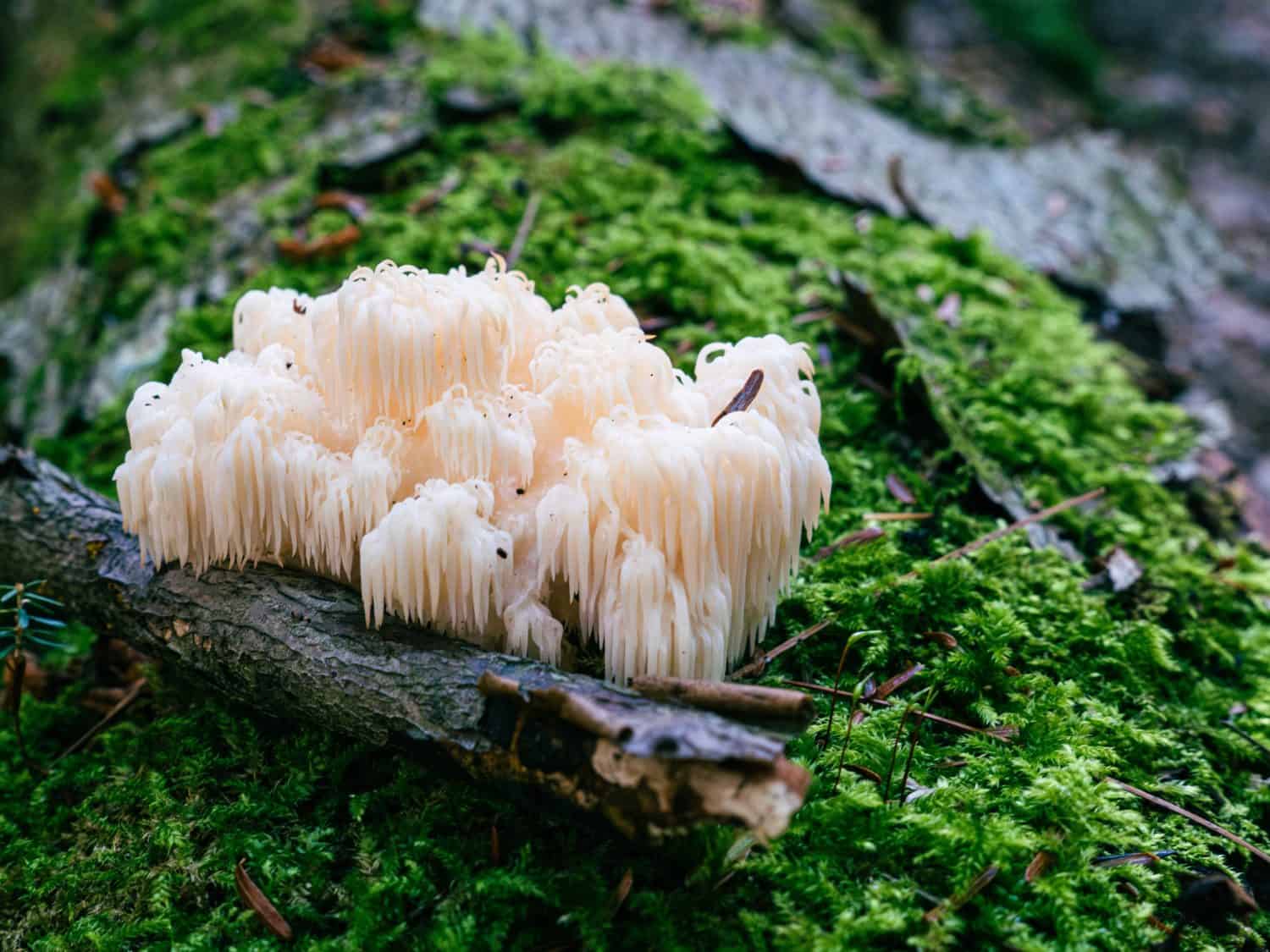
Bear’s head tooth branches out more than the tightly clumped Lion’s mane.
©Myra Thompson/Shutterstock.com
Knowing where to look for these mushrooms is a good first step to figuring out which is which. If you look for the Hericium americanum, you should look along hardwood trees like oak trees and sugar maple trees. This particular species prefers trees already in decay, primarily within the northerneastern states of the US and the lower part of Canada. It even thrives in a deciduous forest. If you are looking for Hericium abietis you should be looking amongst conifers, specifically in the Pacific Northwest.
While the lion’s mane mushroom lives in North America, it is widely dispersed. It grows on hardwoods, but those hardwoods can be in Europe or Asia as well. They primarily stay within the northern hemisphere, which is how Chinese medicine has been able to use if for generations. Asia may have the highest concentration of these mushrooms, using wood logs and stumps to source them.
Bear’s Head Tooth Mushroom vs. Lion’s Mane Mushrooms: Climate Requirements
If you want to grow these mushroom species, you will find a lot more information on lion’s mane. Hericium in general are considered relatively easy to cultivate. Both mushrooms are edible, but hardwood chips and sawdust are the best substrate for this one. You can also try and grow them on hardwood logs, but they need temperatures of 60-75° F for colonization and fruiting. Like any other fungus, it requires a substantial amount of humidity to grow, reaching 70-80% humidity in its surroundings to grow.
Bear’s Head Tooth Mushroom vs. Lion’s Mane Mushrooms: Size
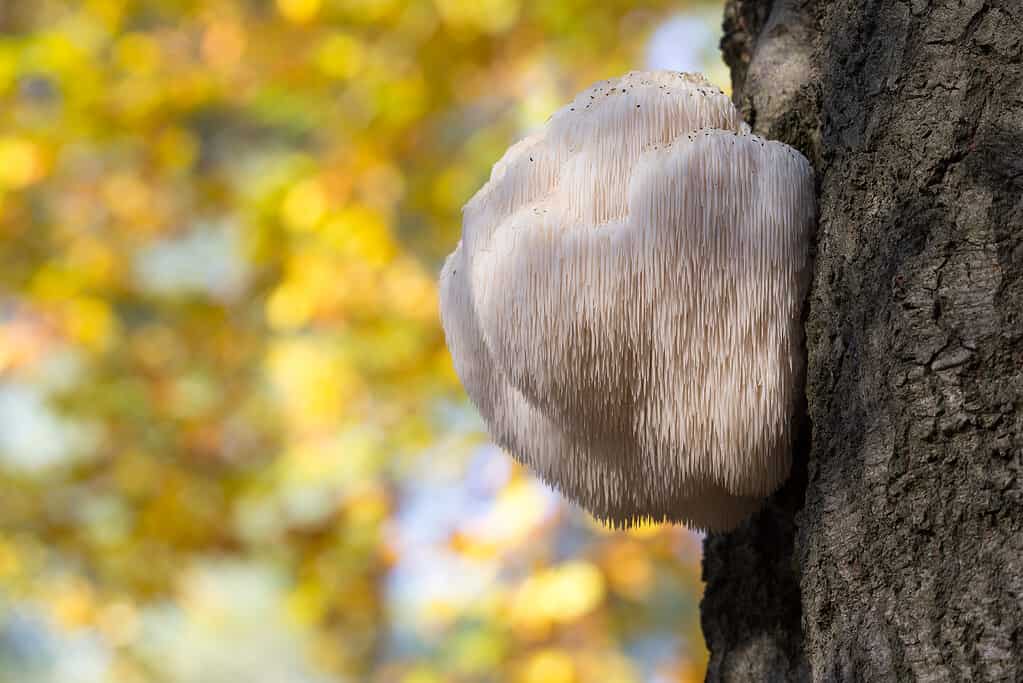
A beautiful lion’s mane mushroom growing from a tree.
©Gertjan Hooijer/Shutterstock.com
The size is the biggest giveaway if you look at these two mushrooms next to each other. Staying true to the massiveness of the predator in its name, the bear’s head tooth mushroom’s fruity body can reach up to a foot wide. The long spines extend 1-4 inches, draping downward.
The spines of the lion’s mane mushroom give it away, growing about half an inch to create the tresses of the wild cat in its name. The fruiting bodies grow much larger, starting at 2 inches long, creating a different contrast than the former’s body.
Bear’s Head Tooth Mushroom vs. Lion’s Mane Mushrooms: Shape
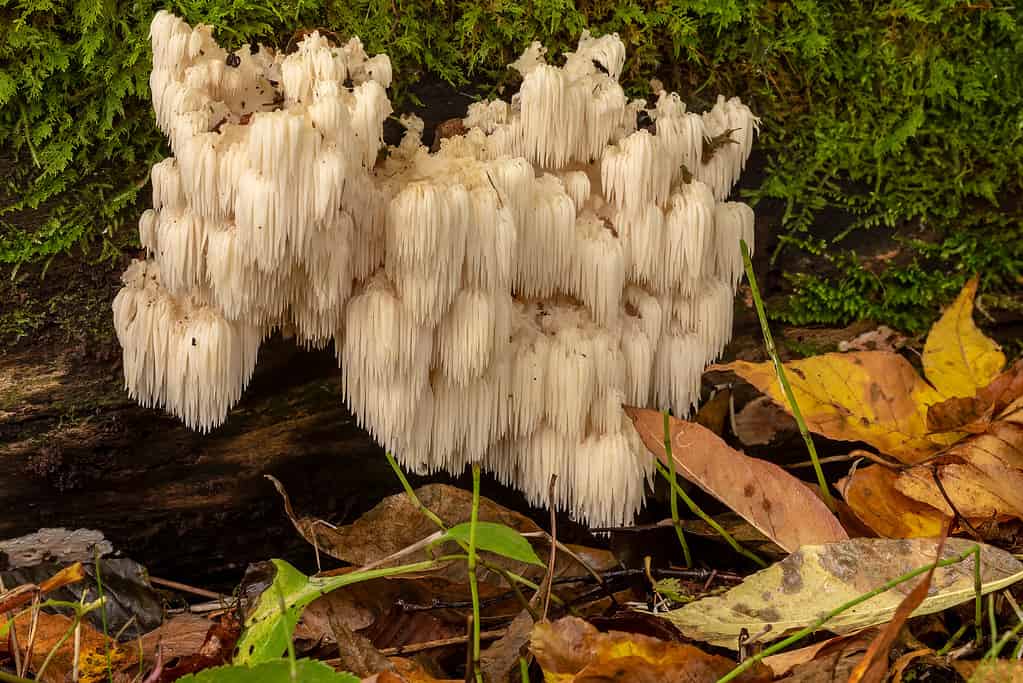
Bear’s head tooth with long spines branching out out.
©Karel Bock/Shutterstock.com
The similarities in the draping and color of the mushrooms are the only reason the shape is essential to identification. The bear’s head tooth mushroom grows relatively large, featuring clusters with trickling fungal “spines” or “teeth” draping down the tree. These tendrils look like dripping candle wax or fungus-based icicles. Once the mushroom goes from white to yellow, the flavor becomes bitter, so harvesting at this state is necessary. The crowding in the lion’s mane mushroom is slightly different, it’s much more tightly clustered but featuring similarly long spines with age.
Bear’s Head Tooth Mushroom vs. Lion’s Mane Mushrooms: Nutritional Value
Since both of these mushrooms are edible, understanding the nutritional content can help you match them to your dietary needs. They contain helpful nutrients, including protein, fiber, antioxidants, iron and vitamin D.
These mushrooms’ biggest nutrients come from its natural thiamine, riboflavin, and Niacin. However, they also support the body with adequate levels of necessary minerals, like zinc, potassium, and manganese.
They do contain some other compounds that are of interest to the medical community as well. Hericenones, erinacines and some other compounds have been proven to help neural regrowth in rats and is being studied for uses in humans in helping with brain health and disease prevention.
Bear’s Head Tooth Mushroom vs. Lion’s Mane Mushrooms: Uses
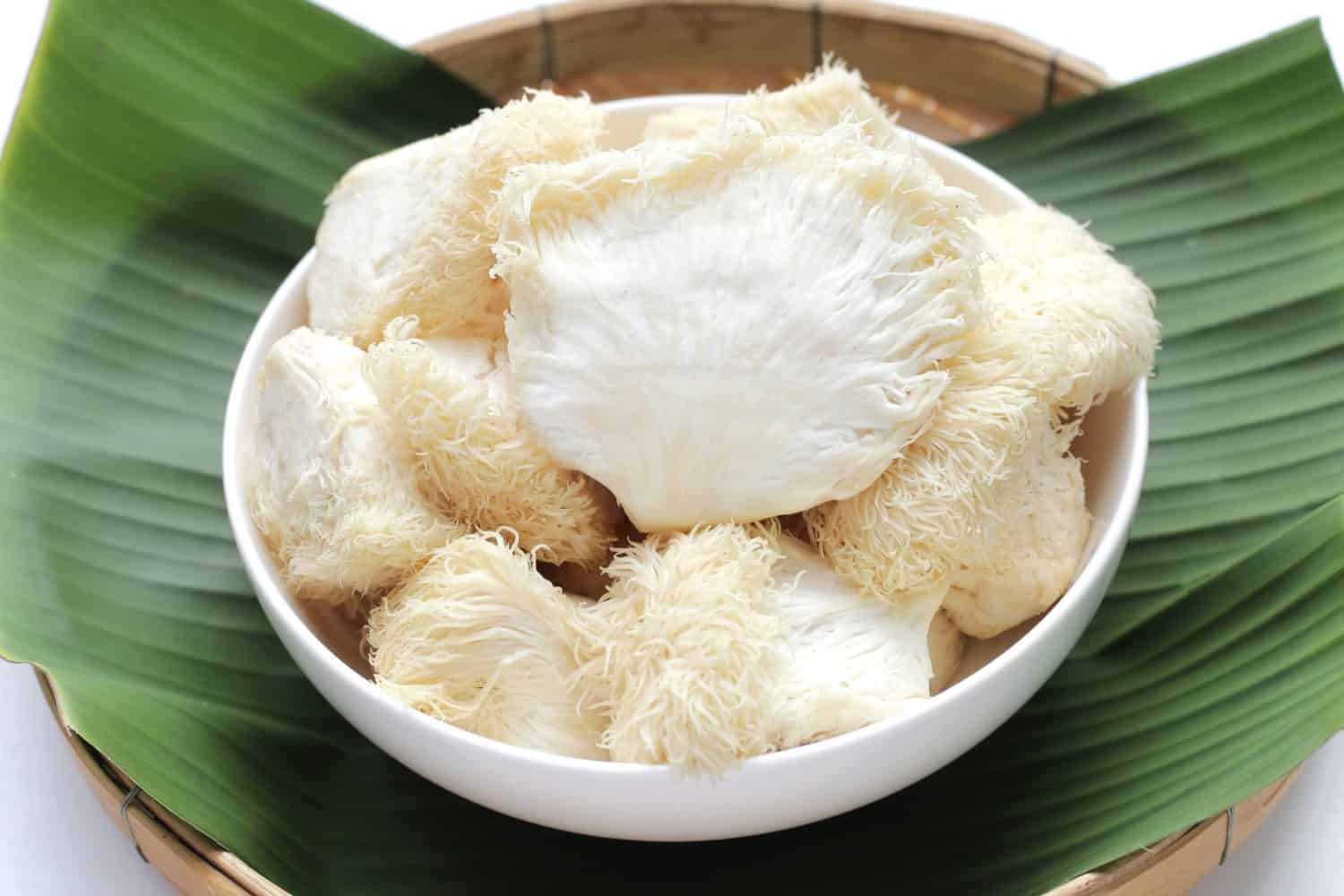
Both mushrooms have a seafood-like texture, allowing you to replace meat in recipes.
©Bowonpat Sakaew/Shutterstock.com
The main reason for harvesting both of these mushrooms is for human consumption. Bear’s head tooth mushroom works well in multiple types of cooking, but they need to be broken into chunks to cook them properly. Some people like pairing them with seafood because of their natural flavors, but they are also in recipes with big flavors like onions, garlic, and sriracha. If you buy them for your food, they won’t last more than a few days in the fridge without losing their good taste.
Lion’s mane mushrooms are also frequently found in recipes, especially for gourmet cooking. With 57% carbohydrates, they blend well in many recipes and provide some protein. Some studies show that they are medicinally used to soothe nerves.
Bear’s Head Tooth Mushroom vs. Lion’s Mane Mushrooms: Flavor
With the proper preparation, bear’s head tooth mushrooms become incredibly tender, releasing their nutty flavor—the meaty texture pairs with the mild taste, which may remind you of seafood. The most common comparisons to this mushroom’s flavor are lobster or crab. Cooking and consuming this fungus quickly after harvest is crucial because the nutty flavor becomes bitter without it. It would be best to cook this mushroom when it is still white to bring out the authentic taste. It works as a meat substitute in many vegan recipes, though it also pairs well with meats like chicken or beef.
Lion’s mane mushrooms have a sweet taste as well, and their texture is reminiscent of shellfish meat. With an earthy undertone, these mushrooms are similar, but are much more easily cooked in bigger steak-like batches due to their shape.
Bear’s Head Tooth Mushroom vs. Lion’s Mane Mushrooms: Seasonal Availability
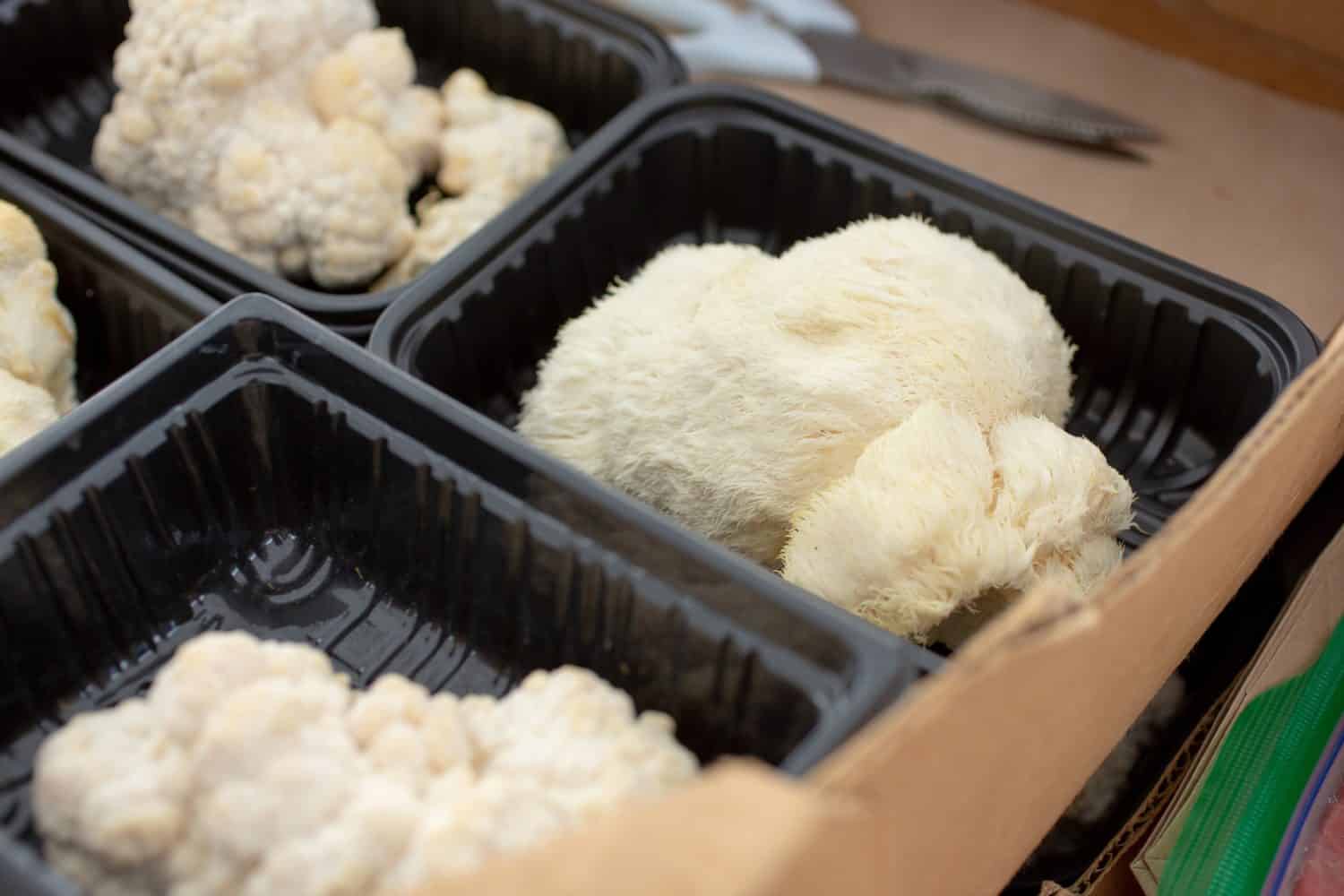
Getting mushrooms soon after cultivation gives you the best flavor for either variation, though bear’s head mushrooms may have a shorter consumption window.
©The Image Party/Shutterstock.com
These mushrooms are ready within the same time of the year with the proper care and cultivation. However, the bear’s head tooth mushroom usually waits until the end of the summer to start flourishing, while the lion’s mane mushroom fruiting starts a few months earlier in April. Lion’s mane mushrooms are much easier to find in nature, so some people cultivate bear’s head tooth mushrooms in controlled settings for access at any time.
Wild Bear’s Head mushrooms can be found in the late summer through early fall, while cultivated Bear’s Head mushrooms are available year-round. You will find that Lion’s Mane will be much easier to find at grocery stores as it is much more widely cultivated.
The information presented on or through the Website is made available solely for general informational purposes. We do not warrant the accuracy, completeness, or usefulness of this information. Any reliance you place on such information is strictly at your own risk. We disclaim all liability and responsibility arising from any reliance placed on such materials by you or any other visitor to the Website, or by anyone who may be informed of any of its contents. None of the statements or claims on the Website should be taken as medical advice, health advice, or as confirmation that a plant, fungus, or other item is safe for consumption or will provide any health benefits. Anyone considering the health benefits of particular plant, fungus, or other item should first consult with a doctor or other medical professional. The statements made within this Website have not been evaluated by the Food and Drug Administration. These statements are not intended to diagnose, treat, cure or prevent any disease.
Thank you for reading! Have some feedback for us? Contact the AZ Animals editorial team.








